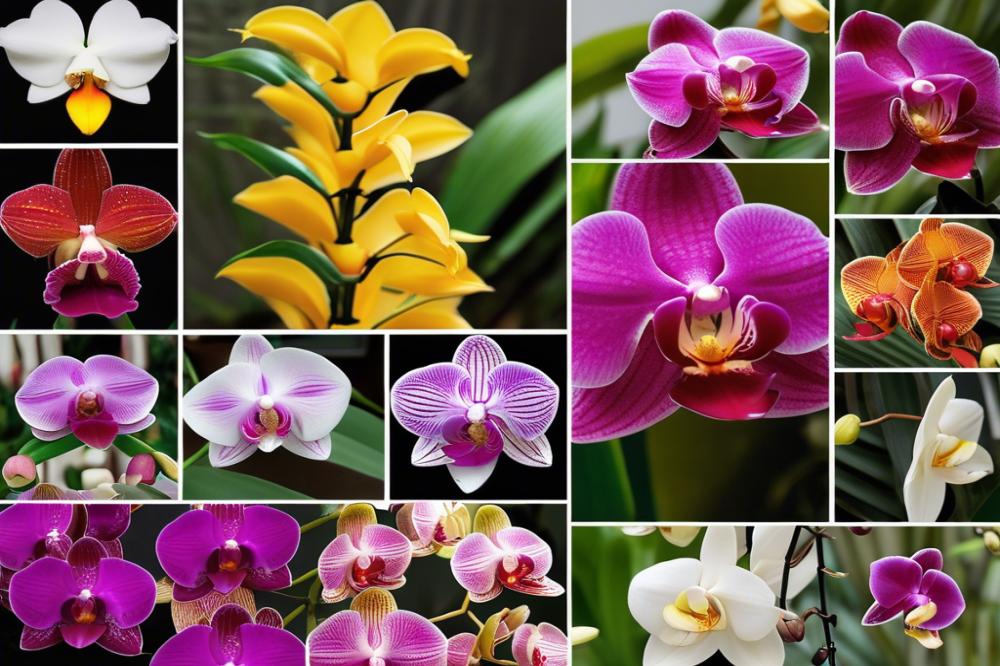Introduction
Orchids have captured the hearts of plant enthusiasts around the globe. Their diverse colors, intricate shapes, and graceful structures make them a favorite among gardeners and collectors alike. From the delicate petals of the Phalaenopsis to the striking patterns of the Cattleya, each type of orchid offers something special. This popularity, however, brings with it the need for proper orchid care.
Understanding the importance of fertilization cannot be overstated. Every orchid has specific nutrient requirements that vary with the plant type. Proper feeding plays a crucial role in promoting healthy growth and enhancing blooms. Many plant owners sometimes overlook this aspect, which can lead to lackluster flowers and diminished plant health. A consistent watering schedule alone is not enough for thriving plants; they also need the right food.
When discussing orchids, one must consider both indoor and outdoor varieties. Each category may require different approaches to cultivation. Indoor orchids often thrive in controlled environments; however, outdoor orchids face the challenges of natural elements. Whether growing in a potting media or a garden bed, how you fertilize your orchids can significantly impact their growth and flowering potential. Using organic fertilizers or slow-release fertilizers can improve the overall health of your plants. It’s essential to tailor the fertilization frequency to the specific needs of each orchid type to achieve optimal results and vibrant blooms.
Understanding Orchid fertilization


Orchid fertilization is a crucial aspect of successful orchid care. It involves providing plant food that contains essential nutrients. These nutrients are vital for the healthy growth and vibrant blooms of orchids. Without proper fertilization, orchids may struggle to thrive or produce flowers.
Key nutrient requirements for orchids include nitrogen, phosphorus, and potassium. Nitrogen promotes lush, green foliage. Phosphorus is important for root development and encourages flowering. Potassium helps strengthen the plant, improving its overall health. These nutrients often come from various fertilizers designed for these beautiful plants.
Differences in nutrient needs exist between indoor and outdoor orchids. Indoor orchids usually grow in more controlled environments. They may benefit from a precise watering schedule and specific types of potting media. Outdoor orchids, on the other hand, face natural elements. They often require organic fertilizers that can break down in natural surroundings. Additionally, fertilization frequency for outdoor orchids might differ due to rainfall and sunlight conditions they experience.
Consideration of orchid types is essential when deciding on fertilization methods. Some orchids might thrive with slow-release fertilizers, allowing for gradual nutrient delivery. In contrast, others may require more regular feeding to maintain their vibrancy. Understanding these differences ensures that each plant receives the best care possible.
Ultimately, the right balance of nutrients and an appropriate fertilization plan lead to successful growth and beautiful blooms. A tailored approach, based on the specific needs of each orchid, makes a significant impact on their health and flowering potential.
Choosing the Right Fertilizer


When selecting the best plant food for orchids, consider their specific needs. Orchids thrive on nutrients supplied in different forms. You can choose from organic fertilizers or slow-release varieties. Each option has its benefits for indoor and outdoor plants.
Organic fertilizers are derived from natural sources. They promote healthy growth while enhancing potting media. These products enrich the soil, releasing nutrients over time. This slow nutrient release is ideal for orchids, preventing plant shock and enhancing bloom quality. Many growers find that organic fertilizers also improve the overall health of the plants.
Alternatively, slow-release fertilizers offer convenience. These granules gradually dissolve, providing a steady supply of nutrients. This method simplifies the fertilization frequency, which is beneficial if you’re busy. Orchids enjoy a mix of nutrients; therefore, both methods can work well in balance.
Liquid vs. Granular Plant Food
Liquid plant food delivers nutrients directly to the roots. This method provides an instant boost, ideal for plants needing immediate care. Application is typically easy; just dilute with water and apply. Keeping in mind your watering schedule is crucial here, as too much liquid can lead to root rot.
Granular options ease worries about frequent applications. They are often mixed into the potting media. Over time, they release nutrients, making it simpler to maintain a routine. Each type of fertilizer has distinct advantages, but the choice often comes down to personal preference.
Recommendations for Specific Orchid Types
When seeking plant food for specific orchid types, remember they each have unique nutrient requirements. Phalaenopsis orchids benefit from balanced fertilizers, as they often bloom multiple times a year. For Cattleya orchids, a slightly higher phosphorus ratio can aid in bloom enhancement.
Dendrobium orchids also thrive with a fertilizer rich in nitrogen during their active growth. Be sure to tailor your approach based on the species. Regular assessments of plant health can guide adjustments in fertilization. Observing growth patterns will help you find a rhythm that suits your collection.
Orchid Care Essentials


Importance of Potting Media in Nutrient Retention
The choice of potting media plays a crucial role in how well orchids thrive. Different orchid types have unique needs when it comes to moisture and nutrient retention. Well-draining potting media, such as bark or sphagnum moss, is ideal. These materials help prevent root rot while still holding some water and nutrients. Understanding the specific potting mix for your orchid can significantly influence its overall health. A proper blend of materials allows for effective fertilization and promotes healthy root development.
Relationship Between Watering Schedule and Fertilization
An effective watering schedule works hand-in-hand with fertilization practices. Orchids typically require watering when the top inch of the medium feels dry. However, this also influences how often you apply plant food. For instance, watering heavily dilutes any nutrients in the potting media. It is advisable to fertilize orchids when they are actively growing or during bloom season. Adjusting fertilization frequency according to your watering routine can lead to stronger plants and more vibrant blooms. Watch for changes in growth; this helps determine if adjustments are necessary.
Signs of Nutrient Deficiency in Orchids
Recognizing signs of nutrient deficiency is vital for effective orchid care. Leaves may turn yellow if the plant lacks nitrogen, a common concern. Stripped or browning leaves often indicate potassium deficiency. Over time, inadequate nutrition can diminish the quality and quantity of blooms. Regular leaf inspections can help catch potential issues early. Another sign includes slow growth or a failure to bloom, signaling the need for improved fertilization practices. Being proactive in addressing these issues leads to healthier orchids that can thrive indoors and outdoors.
Bloom Enhancement Strategies


Fertilization techniques play a crucial role in encouraging blooming for orchids. Understanding the specific nutrient requirements of each orchid type can significantly improve flower production. Regular application of balanced plant food enhances the growth cycle by providing essential nutrients. Consider using fertilizers that are designed for orchids, as they typically contain the right balance of macronutrients and micronutrients.
Specific nutrients are essential for bloom enhancement. Phosphorus, for instance, is particularly important for flowering. It’s the nutrient that supports the development of buds and flowers. Additionally, potassium contributes to the overall health of the plant and promotes robust blooms. Choosing a fertilizer that emphasizes these key nutrients will help increase blooming frequency and quality.
Timing of Fertilization
Timing of fertilization significantly impacts blooming cycles. Begin fertilizing your orchids shortly before the expected bloom period. Most orchids have a specific watering schedule that can be aligned with fertilizer application. For instance, many growers recommend a feeding every two weeks during the growing season.
Slow-release fertilizers can be incorporated into the potting media for more consistent nutrient availability over time. Apply these during the early spring, which is typically when orchids start to awaken from dormancy. Adjusting the fertilization frequency based on the specific growth cycle of each orchid type can foster better blooming results. Organic fertilizers are another option that can be beneficial. They release nutrients slowly and improve soil structure, supporting long-term health.
Fertilization Frequency and Timing
Orchid care involves understanding how often to provide the right nutrients. For most orchids, a regular fertilization schedule enhances their health. Typically, once every two weeks during the growing season works well. As fall approaches, this frequency can be reduced to once a month. Over-fertilizing can harm the plant, so it’s better to err on the side of caution.
Seasonal Considerations for Indoor vs. Outdoor Orchids
Indoor orchids benefit from consistent care throughout the year. In the winter months, the growth slows down due to reduced light and cooler temperatures. During this time, cut back on the use of plant food to avoid issues. In contrast, outdoor orchids can thrive with different timings. Since they are more exposed to natural elements, these types may require more frequent fertilization in spring and summer.
Adjusting Fertilization Based on Environmental Conditions
Pay attention to the plant’s environment when deciding on fertilization frequency. Factors like humidity, temperature, and light influence nutrient requirements. If the orchids are in a highly humid area, they may need nutrient boosts more often. On the other hand, drier environments could mean less fertilizer is necessary. When plants are just starting to bloom, consider adjusting nutrient delivery to enhance blooms effectively. Options like organic fertilizers or slow-release fertilizers can provide a more gradual nutrient supply, benefiting long-term growth.
Choosing the right potting media also plays a role in how often to fertilize. Some mixes retain moisture better than others, affecting how quickly nutrients are utilized. Monitor how your orchids respond to fertilizer. If the leaves appear discolored or growth is stunted, reevaluating the fertilization strategy may be needed.
Common Mistakes in Orchid Fertilization
Orchid care requires a careful balance of various factors. One of the most significant errors made by growers is over-fertilization. This can harm orchids, leading to root burn or poor growth. Roots may become damaged, causing the plant to struggle. Moreover, excess salts from fertilizers can build up in potting media, which further complicates plant health.
Another problem arises from misunderstanding the nutrient needs based on different orchid types. Different species have distinct requirements for specific nutrients. For instance, some may benefit from higher nitrogen levels, while others thrive on phosphorus-rich formulas. A one-size-fits-all approach often leads to poor results and disappointed orchid owners.
Following a consistent fertilization routine is essential for healthy growth and bloom enhancement. Skipping applications or applying plant food too sporadically can disrupt the plant’s natural cycles. It’s advisable to align fertilization frequency with watering schedules, as this aids in nutrient uptake. Choosing between organic fertilizers and slow-release fertilizers can also influence growth, depending on individual plant needs.
Pay careful attention to how your orchids respond to different fertilizing methods. Noticing changes in foliage or blooming can provide clues to their nutrient requirements. By keeping these common pitfalls in mind, you can help your indoor or outdoor orchids thrive and showcase their beauty.
Wrapping Up Orchid Care
Fertilizing orchids is crucial for their overall health and beauty. Knowing the right approach can make a significant difference. Always remember to use the correct type of plant food. Water-soluble options are often preferred for their ease of use. Timing can also affect success; fertilizing during the growing season will give your orchids the nutrients they need to thrive.
Additionally, diluted solutions can help prevent any damage to delicate roots. Adjusting frequency based on the specific needs of your orchids is wise. Not every plant requires the same amount of nourishment. Some varieties may thrive with more or less fertilization. Pay attention to how your plants respond to discover what works best.
Taking proper steps in orchid care will lead to impressive blooms and lush foliage. Healthy orchids will reward you with vibrant colors that can brighten any space, indoors or outdoors. Establishing a regular fertilization routine can be very beneficial. Don’t hesitate to experiment a little to find the best method for your situation.
In conclusion, enjoying healthy, thriving orchids comes down to your dedication to their needs. A well-balanced approach to fertilization allows these unique plants to flourish beautifully in your home or garden. With the right care, you can cultivate a stunning display that will capture attention and admiration.



